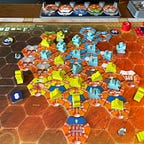Board Games
On Mars: My Favorite Eurogames #1
“Be a part of the first Martian colony, striving to be the best contributor.”
by Eagle-Gryphon Games, designed by Vital Lacerda, art by Ian O’Toole
A game for 1–4 players with a playtime of 90–150 minutes for ages 14+.
Beneath the surface of the beautiful art, finely-crafted components, and complex gameplay rests a beast of a eurogame.
Some say On Mars is a hot mess. A game too complex for its own good. A game in which a playthrough without consulting the rulebook feels like unlocking a special achievement. Others call it Vital Lacerda’s magnum opus. A game that hits all of the sweet spots for Eurogamers who like to sit down to something on the heavy side and ponder their way through 2+ hours of crunchy decisions.
If the BGG On Mars page is any indication of complexity, then the latter group is absolutely right. Coming in at a whopping 4.65 (out of 5), it’s a really heavy game. To find another game rated that complex we must venture from the BGG top 500. It’s a testament to Lecaerda that On Mars ranks near the top 50 games of all-time. It’s also the beloved designer’s highest-rated game, above such gems as The Gallerist, Lisboa, and Vinhos.
Why do I love On Mars?
1) It’s a crunchy worker-placement game. On Mars has a dual-sided placement board with restrictions on how and when players gain access to the opposite side actions. There’s an Orbit side and a Colony side, both providing different placements for the hard-working meeples who have braved the cold depths of space in the name of discovery.
The Orbit side placement actions help players get resources and prerequisites they’ll need to assist in the further development of the 1st Martian colony. Players gain resources including water, oxygen, batteries, plants, minerals, and crystals.
They can also gain (as well as improve) technologies, acquire blueprints, and use workers to return to the colony in a hurry if needed. In the beginning, players will move between the Orbit and Colony sides often, building up income as they do so. But as the colony becomes more self-sufficient with more and more worker meeples to distribute, players will spend the last part of the game focusing on Colony side actions.
On the Colony side, players will construct buildings, develop advanced structures, make discoveries and gobble up crystals, and gain workers, robots, and scientists. Finally, players will acquire Earth contracts which will provide much-needed endgame victory points.
It’s often unclear which action is best at any given time or even when one should travel from orbit to colony or vise-versa. That’s because there are a lot of paths to victory in On Mars. It isn’t a “solvable” game. Opponents can slow you down by blocking an important action space or taking the last of a crucial resource. That’s why I keep coming back to it.
2) I love the art style and the components. The game looks great on the table and if playing at a local coffee shop, like my playgroup often does, we get lots of interested onlookers. It’s stylish without taking itself too seriously. The fun colors that make the components easy to differentiate, even for color-blind players, is part of its charm. The iconography is extensive but logical. The board layout makes sense and the insert helps get the game started as well as put away in a hurry.
3) It looks strategic but is more tactical. I originally approached On Mars as a long-term planning and sequencing type of game. This lead to big-time analysis paralysis and the feeling that perhaps this game was beyond me. It wasn’t until I’d played 6+ times that I realized it was more important to remain flexible and responsive to what opportunities presented themselves from turn to turn.
What are the other players likely to do before your next turn? What will be your best options? Can you build a mine before they do?
Don’t stick to a plan. Exploit the opportunities left by the other players as the game unfolds.
4) This is Not Terraforming Mars. I purchased Terraforming Mars years ago because I was interested in the theme of exploring Mars, and everyone seemed to rate it highly. Unfortunately, I didn’t enjoy it. It went on too long for what was essentially a solitaire game with optional drafting. I found myself not caring if I would win or lose near the end. I just wanted the game to end.
On Mars is the one for me. = )
This is the first of a series of articles that will focus on some of my favorite Eurostyle board games! If you haven’t read my article on Kanban EV, check that one out here!
What are some of your favorite Eurogames? Do you like or dislike On Mars? Please take a moment to click the Follow button if you enjoy the type of articles I write. This helps me to write more in the near future. Our hobby deserves more content for board gamers to read and not just YouTube videos to watch. Thanks for reading!
-the BoardGameNerd
